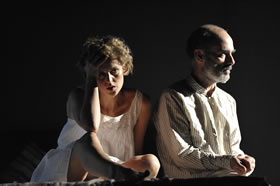An American Classic Let Down by Clumsy Direction
Penny Flood reviews 'Desire Under The Elms' at the Lyric Theatre
Desire Under the Elms by Eugene O’Neill is loosely based on the Greek myth of Phaedra, transposed to a remote farmstead in New England in 1850. Put simply, it’s the story of a woman who falls in love with her stepson and it all ends in tears.
Published in 1924, it is now generally considered a great American classic, so it’s a disappointment that this highly anticipated production at the Lyric Hammersmith has been spoilt by clumsy design and direction.
It opens with the two elder brothers of the family at the centre of the play, Peter (Fergus O’Donnell) and Simeon (Mikel Murfi), as a sort of Greek chorus chatting in a way to that sets the scene for what’s to come. Sadly, they play this as comedy, like two loud bearded hicks familiar in comedy westerns, so the whole thing gets off to the wrong start. They’re not meant to be funny (and humour not intended by O’Neill crept in later in the play’s most tragic moments, leading to some audience titters). The brothers are actually like the other characters in this play: down trodden, sad, desperate and filled with superstition.

Denise Gough (Abbie Putnam) and Finbar Lynch (Ephram Cabot)
Pictures by Keith Pattison
They are called to supper by their younger half-brother Eben (Morgan Watkins), a desperately sad and love-starved young man who still misses his dead mum. Later, their father Ephraim Cabot (Finbar Lynch) turns up with his attractive younger wife Abbie (Denise Gough) and the action takes off towards its tragic, heart-stopping end.
Gough is particularly moving as the passionate Abbie seeking to make the most her last chance of love and security. Lynch fulfils O’Neill’s description of Cabot as being like a ‘old bare hickory tree fit only fur burnin', who is ‘growing ripe on the bough’ (there are many repeated phrases like this which adds a poetic dimension to the otherwise colloquial language). The third side of the triangle, Eben, is a difficult character to play because of his mood swings as he is carried along in the wake of the emotional forces around him, but Watkins does it movingly, particularly in his brief period of blissful blossoming.

Picture; Keith Pattison
In O’Neill’s skilful hands, lust, incest, greed, superstition, religion and patriarchal bullying are combined to great effect to invoke the spirit of the age and place. A couple of nice touches in this production are the musician Jason Baughan who pops up with country and western type guitar solos between the scenes, as well as generally clever, atmospheric lighting by James Farncombe – although in one crucial scene too much is played out in dark shadow.
However, O’Neill was very specific in his stage directions. First of all he wanted ‘two elm trees .... that brood over the house’. They’re where the title comes from but have just been missed out of this production. Most of the action takes place in the kitchen and bedrooms of the homestead, which are unfortunately represented by big boxes that are clunkingly wheeled on and off or spun around the stage They’re cumbersome and noisy and break into the flow of the play as each scene change is prefaced with a great deal of fuss as members of the poor cast have to trundle them into and out of place. Another distraction is the way exits and entrances are made via a raised platform into the stalls.
O’Neill’s stage directions highlight the basic simplicity of the settings, which essentially requires only a few basic items of furniture that could be moved easily in a less distracting stage design. The parlour, which plays a significant role, is described by O’Neil as a ‘grim, repressed room like a tomb in which the family has been interred alive’, with a ‘horsehair sofa’. Here, it is transformed into an erotically-charged space with a sumptuous red velvet sofa that slides about the stage as if in a dream.
Another example of why the trundling boxed rooms are so inappropriate comes at the start of the second act, which opens with a party to celebrate the birth of Abbie’s baby. Instead of using the full space of the stage, the action all happens in one crowded wheeled-on room and the dancing becomes a series of cramped stamping movements, not unlike the haka that precedes an All-Blacks rugby match.
I feel that if you’re going to put on one of the classics, it should be messed with only if your changes take it to new levels and brings fresh insights. This does not happen under Sean Holmes’ direction. But this is such a significant play, and there is still so much to savour in it, that your time won’t be wasted seeing it.
Desire Under the Elms runs until November 10 at the Lyric, and is suitable for 14 years and upwards. You can find dates and times of performances here.
October 10, 2012